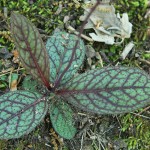By Heather Soulen
In the spirit of the Halloween season, we’ve decided to showcase some of the more darkly inspired scientific names. But first, what exactly is a scientific name, and how did it come to be? In the 18th century, Carl Linnaeus developed a hierarchical naming system known as Linnaean classification for categorization of organisms. As part of his classification system, Linnaeus introduced binomial nomenclature, a formal system for giving organisms a two-part scientific name. The first part of the name is a word that identifies the genus to which a species belongs. The second part of the name is a word that identifies a species within a genus. Scientific names are often in Latin, Greek or some other ancient or classical language, and may reflect some special aspect or feature of that organism. For example, an organism with stripes, bars or a mottled appearance may have a species name of variegatus, Latin for variegated.
However, some scientific names have Latin and Greek words that are less innocuous. Some words conjure up images of terror and the occult. When whispered, the names seem to slither like a snake over the tongue – sending chills down spines and making hairs on the back of the neck rise like ghosts from a grave. This week we delve into science’s darker and more twisted scientific names.
Vampires
The word vampire can mean very different things to different people. Undead, Vrykolakas, Strigoi, Vampyre, Nosferatu and Dracula are just a few names that invoke thoughts of mortality and even morality. What would possess a scientist to apply any of these words to an organism’s scientific name?
-

Dracula vampira flower. Photo: Eric Hunt, licensed under CC by 3.0
The Vampire Orchid or Dracula Orchid (Dracula vampira) is an epiphytic orchid found high in the cool cloud forests of western Ecuador and Columbia some 1,800-2,200 meters (5,900-7,200 feet) above sea level. While one might think that the genus Dracula refers to the infamous fictional character Dracula, here it means ‘little dragon’ after the imagined appearance of a dragon in the flower. Dracul comes from the Romanian word drac which means devil and is derived from the Latin word draco which means dragon.
- The Vampire Squid from Hell or Vampire Squid (Vampyroteuthis infernalis) is a cephalopod living in the deep recesses of the world’s temperate and tropical oceans. Named for its black as midnight skin, caped appearance, and eyes that at times appear blood red, this squid struck fear into those that those that dared to gaze upon it. Great naturalist and explorer William Beebe (1926) was said to describe Vampyroteuthis infernalis as “a very small but terrible octopus, black as night with ivory white jaws and blood red eyes.” Vampyrus is Latin for vampire, teuthis is Greek for squid and infenalis is Latin for Hell or Hellish. The scientific name for this squid is quite literal.
MBARI video of Vampire Squid
Phalaris the Tyrant
Phalaris is a genus of canarygrass in the family Poaceae. It is found in a wide variety of habitats and environments that range from boggy marshes to dry locations, and from below sea level to thousands of feet above sea level. What could possibly be so gruesome with a seemingly common grass like Phalaris?
The name Phalaris hearkens back to ancient times when “Phalaris the Tyrant of Acragas/Agrigento” ruled Sicily in the 6th century BCE. Known for his excessive cruelty and even cannibalism, he commissioned a Greek artist to create a hollow bronze bull specifically for the purpose of roasting his victims alive. The bull was said to be outfitted with an acoustic device that would convert a victim’s screams into a bull’s deep bellow. Contrary to these legends, Phalaris was also said to be a humane and cultured man. Guess that point of view depended on what side (i.e. inside or outside) of the bull one was sitting.
Spells and Invocations
Sometimes scientific names sound like spells from a Harry Potter movie. Below is a list with six sets of Latin/Greek word pairings. Test your scientific name and Harry Potter spell knowledge by guessing which pairings are actually scientific names for plant and which are Harry Potter spells. Click on each to reveal the true nature of these words. Hint: only two of the six are plant species.
The Rattlesnakeweed or Rattlesnake Hawkweed (Hieracium venosum) and Slim Amaranth (Amaranthus hybridus) are both native plants to the United States and have been found here at SERC. Hieracium is derived from the Greek word hierax which means hawk and venosum is derived from the Latin word venosus which means full of veins or vein, as in its leaves. Amaranthus is derived from Greek word amarantos which means unfading. The Greek word Anthos means flower, and hypridus is Latin for hybrid.
The darker side of taxonomy can be quite literal, wicked and unsettling. The next blog piece will delve deeper into the darkly twisted world of binomial nomenclature and explore the haunting myths, lore and mysteries surrounding a few more heinous scientific names.

![Hollow bronze bull created by sculptor Perillus. Photo: Pierre Woeiriot [Public domain], via Wikimedia Commons](https://sercblog.si.edu/wp-content/uploads/2015/10/Pierre_Woeiriot_PhalarisSMALL-150x150.jpg)


A few more:
Lucifer, a genus of shrimps- our local species is Lucifer faxoni
A deep-sea octopus- Vampyroteuthis infernalis
Satan eurystomus- Widemouth Blind Catfish- known only from deep artesian wells in Texas
Happy Halloween,
Paul
Thanks for this fun and informative site! What a great way for the biologically minded to celebrate Halloween!